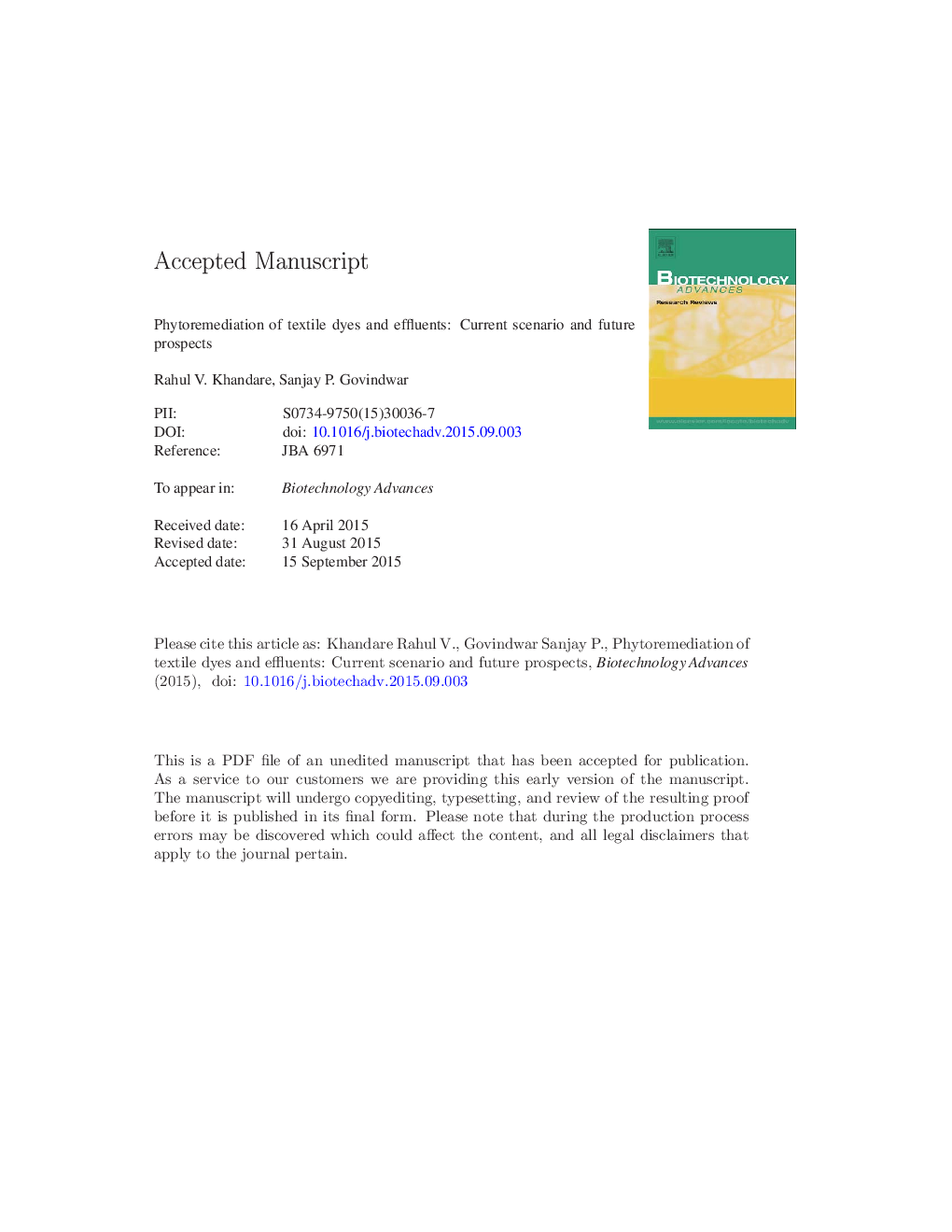| کد مقاله | کد نشریه | سال انتشار | مقاله انگلیسی | نسخه تمام متن |
|---|---|---|---|---|
| 10231396 | 1190 | 2015 | 83 صفحه PDF | دانلود رایگان |
عنوان انگلیسی مقاله ISI
Phytoremediation of textile dyes and effluents: Current scenario and future prospects
دانلود مقاله + سفارش ترجمه
دانلود مقاله ISI انگلیسی
رایگان برای ایرانیان
کلمات کلیدی
TOCLIPDCIPHPTLCBODTDSTSSdichlorophenol indophenolADMIPPOGC–MS - GC-MSLC–MS - LC-MSUV–Vis - UV-VisConstructed wetlands - تالاب ساخته یا تالاب مصنوعیBiological Oxygen Demand - تقاضای اکسیژن بیولوژیکیchemical oxygen demand - تقاضای اکسیژن شیمیاییDecolorization - رنگ زداییTextile dyes - رنگ نساجیMetabolic fate - سرنوشت متابولیکToxicity - سمی بودنFTIR - طیف سنج مادون قرمزliquid chromatography–mass spectroscopy - طیف سنجی جرم کروماتوگرافی مایعgas chromatography–mass spectroscopy - طیف سنجی جرم کروماتوگرافی گازFourier transform infrared spectroscopy - طیف سنجی مادون قرمز تبدیل فوریه یا طیف سنجی FTIREffluents - فاضلابlignin peroxidase - لیگنین پراکسیدازTotal dissolved solids - مجموع جامدات حل شدهtotal suspended solids - مجموع مواد جامد معلقPolyphenol oxidase - پلی فنول اکسیدازCod - کادوhigh performance liquid chromatography - کروماتوگرافی مایع با کارایی بالاHPLC - کروماتوگرافی مایعی کاراhigh performance thin layer chromatography - کروماتوگرافی نازک با عملکرد بالاTotal organic carbon - کل کربن آلیPhytoremediation - گیاه پالایی
موضوعات مرتبط
مهندسی و علوم پایه
مهندسی شیمی
بیو مهندسی (مهندسی زیستی)
پیش نمایش صفحه اول مقاله

چکیده انگلیسی
Phytoremediation has emerged as a green, passive, solar energy driven and cost effective approach for environmental cleanup when compared to physico-chemical and even other biological methods. Textile dyes and effluents are condemned as one of the worst polluters of our precious water bodies and soils. They are well known mutagenic, carcinogenic, allergic and cytotoxic agents posing threats to all life forms. Plant based treatment of textile dyes is relatively new and hitherto has remained an unexplored area of research. Use of macrophytes like Phragmites australis and Rheum rhabarbarum have shown efficient removal of Acid Orange 7 and sulfonated anthraquinones, respectively. Common garden and ornamental plants namely Aster amellus, Portulaca grandiflora, Zinnia angustifolia, Petunia grandiflora, Glandularia pulchella, many ferns and aquatic plants have also been advocated for their dye degradation potential. Plant tissue cultures like suspension cells of Blumea malcolmii and Nopalea cochenillifera, hairy roots of Brassica juncea and Tagetes patula and whole plants of several other species have confirmed their role in dye degradation. Plants' oxidoreductases such as lignin peroxidase, laccase, tyrosinase, azo reductase, veratryl alcohol oxidase, riboflavin reductase and dichlorophenolindophenol reductase are known as key biodegrading enzymes which break the complex structures of dyes. Schematic metabolic pathways of degradation of different dyes and their environmental fates have also been proposed. Degradation products of dyes and their fates of metabolism have been reported to be validated by UV-vis spectrophotometry, high performance liquid chromatography, high performance thin layer chromatography, Fourier Transform Infrared Spectroscopy, gas chromatograph-mass spectroscopy and several other analytical tools. Constructed wetlands and various pilots scale reactors were developed independently using the plants of P. australis, Portulaca grandiflora, G. pulchella, Typha domingensis, Pogonatherum crinitum and Alternanthera philoxeroides. The developed phytoreactors gave noteworthy treatments, and significant reductions in biological oxygen demand, chemical oxygen demand, American Dye Manufacturers Institute color removal value, total organic carbon, total dissolved solids, total suspended solids, turbidity and conductivity of the dye effluents after phytoremediation. Metabolites of dyes and effluents have been assayed for phytotoxicity, cytotoxicity, genotoxicity and animal toxicity and were proved to be non/less toxic than untreated compounds. Effective strategies to handle fluctuating dye load and hydraulics for in situ treatment needs scientific attention. Future studies on development of transgenic plants for efficacious phytodegradation of textile dyes should be focused.
ناشر
Database: Elsevier - ScienceDirect (ساینس دایرکت)
Journal: Biotechnology Advances - Volume 33, Issue 8, December 2015, Pages 1697-1714
Journal: Biotechnology Advances - Volume 33, Issue 8, December 2015, Pages 1697-1714
نویسندگان
Rahul V. Khandare, Sanjay P. Govindwar,